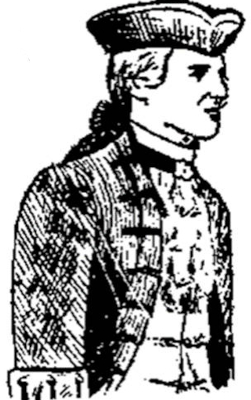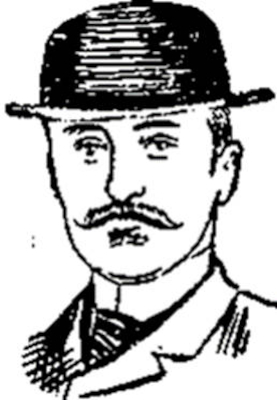This article has been transcribed from a copy of the Cardiff Times in the online collection of scanned Welsh newspapers 1804-1919 in the National Library of Wales, with grateful recognition of the free access accorded to all readers. Paragraph breaks have been introduced for easier reading.
Explanatory notes
'Mr John Box of immortal memory': all the characters mentioned are all in Box and Cox, a one act farce by John Maddison Morton, based on a French one-act vaudeville, Frisette, produced in Paris in 1846. Box and Cox was first produced at the Lyceum Theatre, London, on 1 November 1847. The reference is topical because of Arthur Sullivan’s one-act comic opera, Box and Box; or, The Long-Lost Brothers, based on this play and with a libretto by F. C. Burnand, was performed in 1886.
'a slouching walk, a terrier dog, and a thick stick' is perhaps a memory of George Cruikshank's illustration to Part 21 of Dickens’s Oliver Twist Sikes attempting to destroy his dog.
'a gentleman who annexed an asinine quadruped' may refer to an incident in Cervantes’s Don Quixote.It is Sancho Panza, the rider of the donkey, who wears a white hat. His donkey is stolen in chapter 23 by Gines de Pasamonte, the colour of whose headgear is not, I believe, mentioned. (The theft is at night.)
Elsewhere 'Samuel' defines a masher as 'the sort of young man who fancies that he can overcome and overawe everybody by the potency of his attractions' (12th May 1888) How to Live Within One's Means
The crush hat was originally a hat that collapsed, and could be carried under the arm, and when expanded was held in shape by springs; later any hat not damaged by compressing; for example a ‘gibus’: a spring-loaded, collapsible top hat or 'opera hat', named for its inventor, Antoine Gibus. —— David Skilton
When Mr John Box of immortal memory met the gentleman named Cox, who, without his knowledge or consent, shared his apartments, the thing which struck him most forcibly was the variety of his headgear. Mr Box observed to his deceiving yet obliging landlady, Mrs Bouncer, that he had seen the gentleman in tall hats and short hats, hats with broad brims and hats with narrow brims, hats with nap ,and hats without nap, all of which he had duly noted on the various occasions when he had come across the deceitful hatter. This may be taken as conclusive evidence that a man's hat is a specially noticeable part of his apparel. And so it is, for nothing alters a man's appearance so much as a new-shaped hat.

Staid and respectable.
When one meets an acquaintance who has indulged in the luxury of a new 'tile' the usual remark made is, 'Oh, you’ve got a new hat; you look quite different in it.' And so it is. A man's appearance is generally altered in some degree by the shape of each new hat he wears. This is why it occupies so much time to buy a new hat. Each different shape is tried on, not merely as a test to its size, but as a test to its suitability to the purchaser's features. Some men never look well except in the regulation 'chimney pot,' while others would as soon dream of wearing a 'stove-pipe' hat as of giving double its value for the more common and homely 'billy cock' they usually affect. If one could by any chance see the regulation burglar with his close-fitting fur cap in a tall hat the effect would in all probability be startling;. It is a curious fact in the history of hats that fur caps are invariably associated with crime and criminals. One never dreams of associating respectability with rough-haired caps. They always appear to suggest a slouching walk, a terrier dog, and a thick stick. Yet, by a peculiar process of inversion, the masher in evening, dress not unfrequently dons a tweed cap in place of the crush hat, which is considered the correct thing with dress clothes. Ask the same masher to wear a cap on any other occasion, and he would be simply horrified.

A hat of the past.
Some men there are who wear-the same style of hat all the year round, until their headgear becomes so much a part of them that any change would lead to their being passed in the streets by their friends and their being unrecognised by their close relations. Fashion has no terror for them, and they ignore its dictates with a strength of will worthy of a better cause. Then there are men who like old hats, and wear them until they are so shabby as to be disreputable. Occasionally this peculiar weakness leads to the unpleasant assumption that they do so from motives of economy. A story of one such man occurs to my mind. The subject of the anecdote was very rich, yet he wore a hat so shabby and so antiquated that any of his servants would have declined to put it on. One day a friend remonstrated with him for wearing such a hat. 'Your father,' said the friend, 'would never have worn a hat like that, I'm certain.' To which the penurious one replied, to his critic's astonishment, 'There you are wrong, sir, this was father's hat.'
Some gentlemen there are who always affect white hats. A white hat is popularly supposed to be the badge of a gentleman who annexed an asinine quadruped. But the accuracy of the theory lacks corroboration. The asinine head- gear is usually worn by gentlemen of the old school who, not having gone with the times in the matter of fashion's changes, have a contempt for any other kind of hat than the one they wear. Except in the heat of summer, I have always failed to see the particular virtues of the white hat. But that may be because I never wear one.

The 'Billycock' style.
There is no style of headgear which changes so frequently as the 'billycock' hat, which is most erratic, for it hardly ever remains in one shape for more than a few months at a time. A glance at a collection of these hats worn during a brief period is an instructive and entertaining proceeding. During the operation a man is generally struck by the fact that he must have afforded a peculiar spectacle when he wore such and such a hat in his collection of relics of past fashions. Yet at the time he wore them they each seemed to him the style of hat exactly suited to his peculiar features.
The circle in which the fashion in hats varies but little is that of the Church. Parsons generally lean to the tall hat or the soft felt, and the appearance of one of our pastors in an ordinary' billycock' hat would be indeed a novelty. Straw hats[i] are the harbingers of what does duty for our summer, and of late years they have been in limited demand. They give an air of finish to the cricket or tennis costume, and occasionally enable young men with large ideas to sport coloured bands which may be mistaken for the colours of a university college. Ladies' hats are frequently the cause of much discussion, and they are a far more peculiar order than those of men. One season they are made so high that when worn in places of entertainment they obstruct the view of those behind them, while the next they are worn so small that the wonder is that an epidemic of neuralgia does not result from their use.
One thing that bothers men in the matter of ladies' headgear is the difficulty of being certain whether a lady is wearing a hat or a bonnet. It is somewhat embarrassing for a man, when desiring to pay a lady a compliment, says 'What a pretty hat you are wearing to-day,' to be informed with a tinge of contempt, 'Oh, this is not a hat, it's a bonnet.' I believe the ladies have their hats and bonnets made alike for the purpose of enjoying the savage delight of showing their male friends how lamentably ignorant they are. The latest fashion in hats for ladies appears to me to consist of a few pieces of wire and a large collection of flowers, and I am certain that were they to speak the truth those who wear them would say they afford no protection from wind or weather. But they are the fashion, and all women know the value of the old adage which says 'You might as well be out of your mind as out of the fashion.' The hats of both men and women are to some extent revivals of the past, and the curiously-shaped fashionable top hat of the London masher is distinctly suggestive of the sugar-loaf hat of our forefathers. Van-dyke hair and other fashions of a bye-gone age have been adopted by the fair sex, and it would not surprise me one of these days to find the three-cornered hat of the past come into use in the present.
Links to Related Material on Men’s and Women’s Hats
- Victorian Men's Fashions, 1850-1900: Hats
- Victorian fashion and the growth of sporting activities, 1850-1900
- Victorian Women's Fashion, 1850-1900: Hats and Headwear
- What Navvies (Construction Workers) Wore)
Last modified 10 April 2022